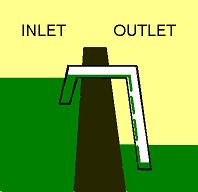Rather than a static network of ponds and streams, the Escapement's pools empty periodically into the stream below. Although pumps or other massive infrastructure could be used to force water across each dam, TiWalkMe will adapt a passive, gravity-powered "bell and siphon" to echo nature's grand cycle. Yet the flow will be as dramatic and as willful as nature's own.
The most elegant and efficient pump in the world is a siphon. Containing no moving parts, requiring no forces other than gravity and surface tension for operation, siphons are at work everyday emptying gas tanks, filtering aquariums, and moving drinking water from reservoir to town.
The siphon principle is simple yet deep. Seemingly defying gravity, a siphon draws water up and over the rim of a dam, perhaps even emptying the pool in the process. Once the column of water in the exterior arm of the siphon drops below the surface of the inlet pool (middle figure), the siphon starts flowing. The longer column of water above the outlet pond exerts greater downward pressure than the downward pressure from the weight of the water on the inlet side, winning the tug of war by pulling on the "rope" of water within the siphon. The effect is similar to a blanket on a bed- once enough blanket has tipped over the side, the entire covering slithers onto the floor.
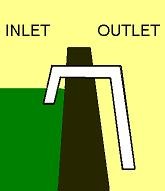 |
 |
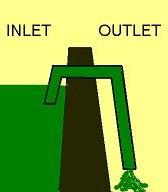 |
Water, of course, is neither a rope nor a blanket, but can be pulled gently before the bonds holding the molecules of liquid to each other shears. Shearing produces bubbles, weakening the rope of water, and breaking the pull of the siphon. This is called "cavitation". For water, any rope 33 feet or higher will break apart- ultimately limiting the siphon's pull to emptying ponds no deeper than 33 feet.
Which leaves just one mystery- how did water get from the inlet pool into the exterior arm in the first place, so the siphon could begin operation? Filling the exterior arm is called "priming", and various schemes have been developed to prime a siphon.
Normally, a siphon is primed by pulling water into the siphon by attaching a vacuum pump to the outlet. Often, the vacuum pump is a simple as a pair of lips sucking on a straw, or as complex as a gas-powered turbine. In either case, vacuum is required for only a moment- once primed, the pump runs without further intervention.
There are a special class of siphons used to periodically, and rapidly, empty a tank or pond which is continuously filling up. These are called a "dosing siphon", or a "bell and siphon", and characteristically are self-priming again without any moving parts.
In a bell and siphon, the outlet siphon's lip is submerged in the outlet pool (left figure). The water acts like a pressure relief valve, preventing water from flowing through the siphon until the pressure relief "valve" opens. The figure below illustrates one cycle of the Bell and Siphon in operation, and how the pressure relief value causes the siphon to self-prime. As the water in the upper pool rises above the siphon's inlet lip, the siphon is sealed at both ends (3a). Air, trapped within the siphon, resists further water infiltration. As the water level continues to rise, air pressure builds up within the siphon, forcing some water to exit the lower arm, and some water to enter the inlet. If the water rises slowly enough, (so there is enough time for all pressures to come into equilibrium), the height from the water's surface to the water within each siphon arm must be identical for the inlet and outlet.
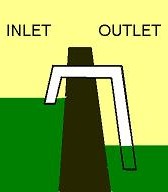 |
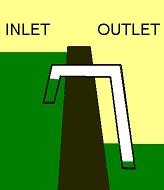 |
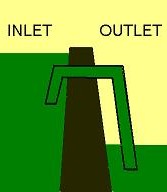 |
Eventually, the pressure is so high, the water level in the outlet arm reaches the outlet lip. A bubble of air emerges, relieving pressure with the siphon, and water explodes through the siphon bend, priming the pump and kicking the siphon into action.
Finally, the upper pond drains below the siphon lip, letting air into the tube, and the rope of water breaks, ending the cycle.
At least this works in principle. In practice, many effects conspire to prevent effective siphon action. For example, air is compressible. The previous, idealized example assumes the trapped air is incompressible and behaves like a weightless flexible piston connecting the two arms. So when water rises in one arm, it pushes out an equal amount of water out in the other arm. On the other hand, if air were extremely compressible, it could not resist the water' entry, and would be ineffective as a pressure relief valve. Air, however, is modestly compressible (try squeezing an empty plastic bottle flat. If the cap is screwed on tight- the air resists quite strongly after an initial push), so this compression must be taken into effect. Which is the origin of the "Bell", in a bell and siphon.
The bell is an enlarged opening on the inlet side. As the water rises, a greater volume of air is compressed on the inlet side, than is pushed down on the outlet side. The bell is sized to correct for the compressibility of air- typically 10% to 20% larger in volume on the inlet than the outlet.
But there are still more subtle effects to consider. For example, "dribbling". If the water level rises very slowly until the pressure relief value is triggered, sometimes only a small steam of bubbles emerge instead of one big gulp. This may reduce air pressure within the siphon just enough for water to rise up to, and continuously dribble over, the siphon bend at which point the siphon never triggers and water level stops rising (below).
Another problem can arise after the first, successful cycle. Instead of the siphon emptying completely of water at the end of the cycle, some air enters, but either waves or quickly rising water seals off both ends of the siphon, stranding some water and air inside. Since there is already some water within the siphon, the siphon will trigger before the water in the inlet pool reaches the bend. Thus the siphon delivers different amounts of flow with each cycle.
The Improved Bell and Siphon:

The TiWalkMe improved Bell and Siphon (cross-section above) avoids most of these problems, by inserting a "latching element" into the system. This latch reliably empties air from the siphon at just the right moment, so it will prime and fire. This latch is the small pipe shown penetrating the wing-shaped dam in the figure. The pipe connects above the siphon bend and down to the outlet pool, where it sits a few inches below the surface. Thus it is normally filled with water, and acts in concert with the siphon as a pressure relief valve. But, since the latch is shorter than the immersed section of siphon below the outlet pool surface, air will push out the water in the small latch pipe before air bubbles emerge from the outlet siphon. Since the end of the small pipe is just below the outlet pool surface, once fired only a small amount of air pressure will keep water from reentering the pipe. Thus, once it triggers it "latches" open, leaking air from the bend until the siphon triggers.
An
accurate, two-dimensional numerical simulation of the latching bell and
siphon was performed by Flow Science,
who generously donated their time and expertise. Click
here to view the very cool results, simulating the beginning of the
cycle (file size about 1.2MB).
Feel free to redistribute content from this site, provided proper attribution and URL are concurrently displayed.

